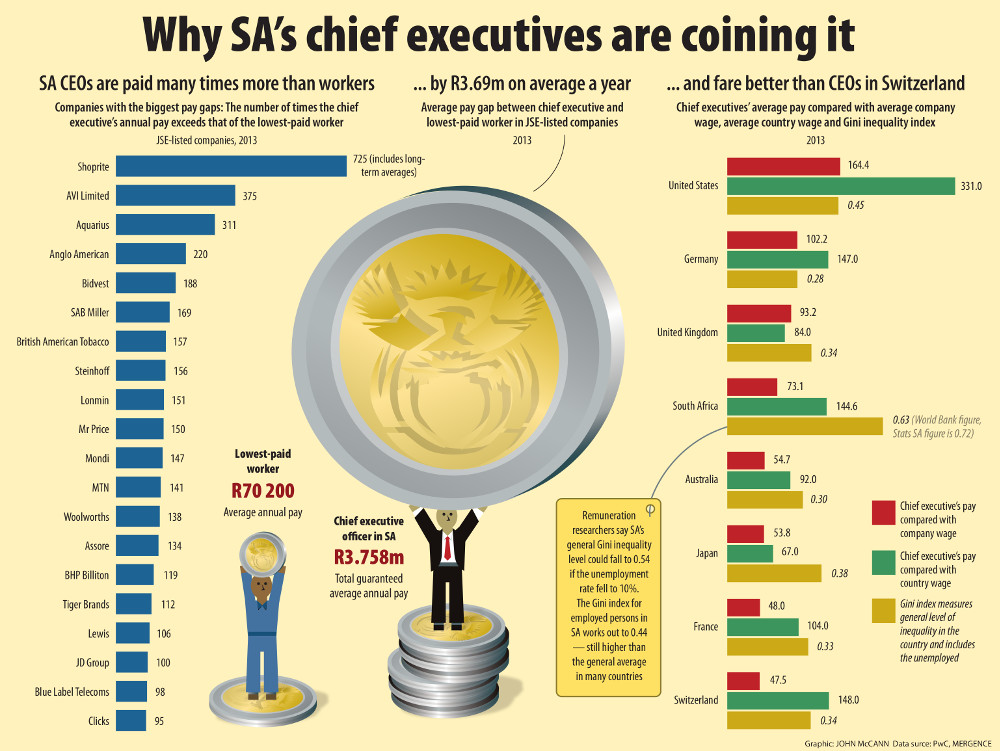COMMENT
The government has embarked on a research initiative into the advisability of introducing a national minimum wage. This research forms part of an important debate that focuses, inter alia, on the wage gap in the country.
This gap was highlighted in a PwC report, Executive Directors’ Remuneration: Practices and Trends, July 2013. PwC’s finding was that the gap between the remuneration of the lowest-paid workers and of the chief executive officers of companies listed on the JSE averaged more than 50 times.
Although the merits of an investigation to close the wage gap from the bottom are clearly understandable, it might be misdirected and looking in only one place to fix the problem of South Africa’s large wage gap. An investigation into a minimum wage ignores the problem of South African executives earning exorbitant salaries and bonuses that place an unnecessary burden on civil society, shareholders and stakeholders.
Excessive executive remuneration reduces the benefits distributable or attributable to stakeholders and civil society (for instance, increased cost of production) and the profits attributable to shareholders. Civil society, stakeholders and shareholders should therefore call executives earning inordinate salaries and bonuses to order. Naturally the remark about excessive remuneration raises the question: What is an exorbitant salary? Is it twice the salary of the president? Perhaps three times? South Africa has no precedent for such restraint.
A case in point is an example from China, where the wage differential in state-owned enterprises between the highest paid and the lowest paid is fixed by the government at 1 to 11.
Wage restraint
In 2011 Venezuela announced a wage restraint for government officials from January 1 2012, although this restraint excludes end-of-year bonuses. From January 1 2012, the highest wage for any public official was set at 12 times the minimum wage, with a prescribed wage restraint structure for other positions. Naturally the application of such a restraint structure is a major challenge, but perhaps easier in Venezuela where remuneration is paid into bank accounts at a state-owned financial institution.
Could the Chinese or Venezuelan examples be models for South Africa? This is a difficult question to answer. Any decision on the level of the maximum wage will not be an easy one. Views differ from person to person, based on their cost of living. Nevertheless, China and Venezuela serve as examples that deserve further investigation.
Large wage gaps are not a unique South African problem. The United Nations Conference on Trade and Development (UNCTAD) (Policy brief number 5, June 2012) has found, inter alia, that “the financial sector’s share of national income has grown almost everywhere, channelling larger profits and ever more generous compensation packages to the wealthy”.

The same UNCTAD policy brief shows that the proportion of income going to the top 1% of the population in South Africa has increased from about 9% in 1996 to some 16.5% in 2011. In a society with a very skew income distribution, evidenced by a large Gini coefficient such as in South Africa, this conduct is simply unacceptable. A restraint on executive remuneration will change the Gini coefficient in favour of lower income earners, even if only at the margin. There will simply be less high income earners.
One random example where restraint seems justified: it has been said that the overall remuneration package of the best-paid executive in the South African banking industry in 2014 amounted to more than R35-million, albeit not all in cash payouts. Only R22.05-million was in cash. The full amount included salary, fringe benefits, bonuses, share options and the like. The full remuneration package is equal to more than R95 000 a day, every day of the week. In a normal (not leap) year there are 30 758 400 seconds. The remuneration therefore equates to more than R1 a second, every second of the day and night.
Market-relates salaries
The explanation is such salaries are market-related. Who should be bluffed by this argument? Collectively chief executives are the market, in this case the market for chief executives of banks. This argument is therefore a tautology: these chief executives are the market, therefore the market is at the level it is. This seems much like these are chief executives setting their own salaries, but hiding behind an amorphous market, as it was once called by a former South African Cabinet minister.
At what point can we expect executives to start feeling any shame about their salaries, or can big egos really push you beyond the level of being able to feel ashamed? Hardly ever has any South African executive publicly stated that this madness must be stopped as they are collectively all overpaid because they are “the market”.
Another argument often raised is that South Africa will lose the skills of these executives if they are not paid these excessive salaries. Civil society can no longer afford these extravagant salaries, which are a bigger burden on the economy than the potential loss of these skills.
It is time for choices. We can either have the government launching an investigation into maximum remuneration in the same way as it launched the investigation into a minimum wage, perhaps following the Chinese or Venezuelan examples. Alternatively, chief executives can exercise voluntary restraint, which is preferable to government regulation.
In the absence of voluntary restraint, the government can use taxation as a way to introduce restraint in executive remuneration. Exorbitant salaries can simply be taxed at exorbitant tax rates to reduce after-tax income to more acceptable levels.
It is time to commence with debate on remuneration levels at the upper end of the wage curve and about the stark choices facing South Africa.
Jannie Rossouw is head of the school of economic and business sciences at Wits University.